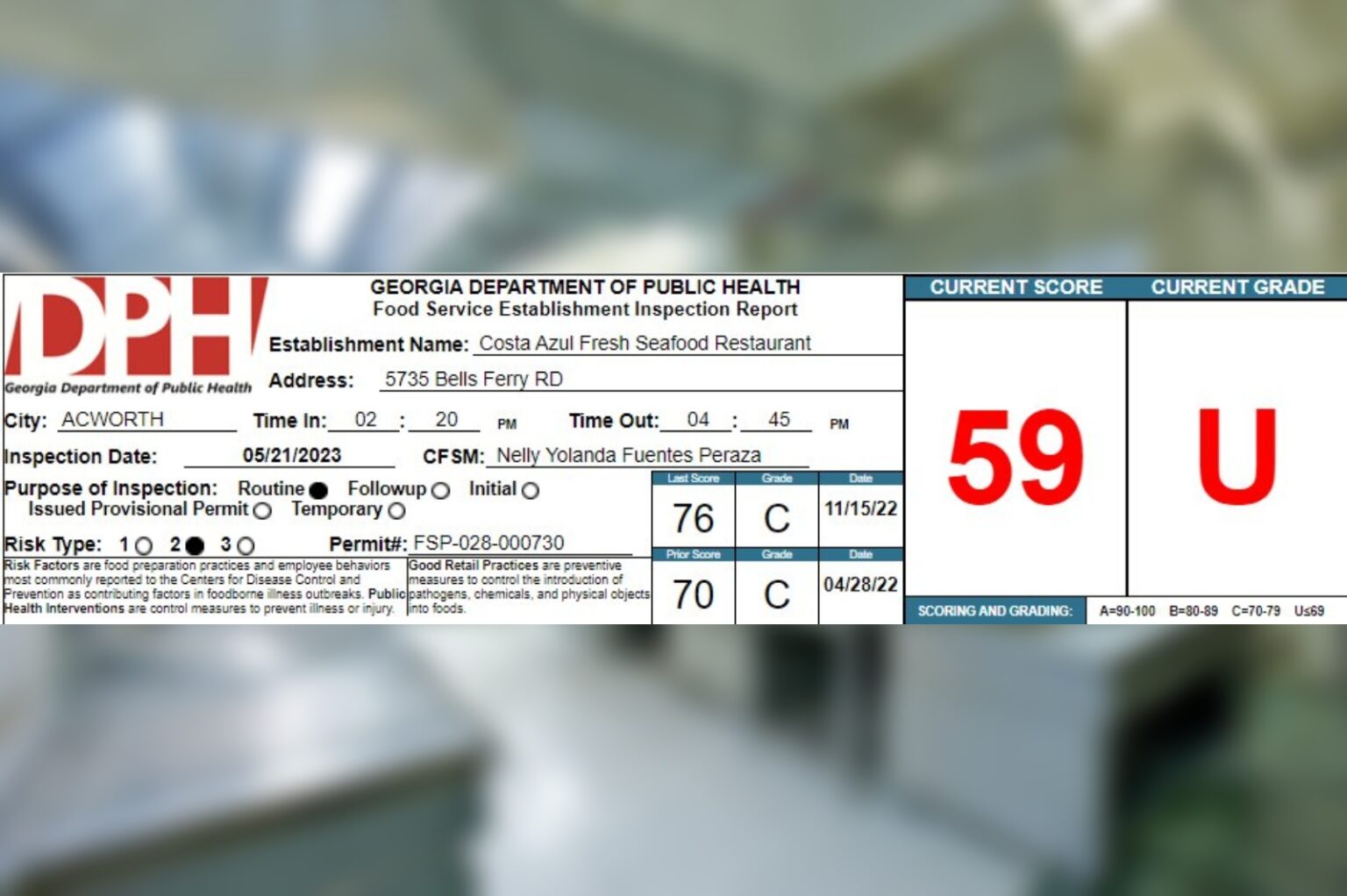Costa Azul Fresh Seafood Restaurant, located at 5735 Bells Ferry Road in Acworth, received a score of 59 points out of a possible 100 points during their 05/21/2023 inspection by the Georgia Department of Public Health.
The violations noted by the inspector were:
Violation #1
1-2A – pic present, demonstrates knowledge, performs duties
Points: 4
Corrected during inspection?: No
Repeat: No
Inspector Notes: Observed no active managerial control at facility an many critical violations that have the potential to cause serious food-borne illness. Several violations are repeat violations from the past two routine inspections. Person in charge must oversee food prep/food handling and coach employees on proper food safety. See the responsibilities of the person in charge below: 511-6-1.03(2)(a)-(l)(n)(o) – Responsibility of PIC (Pf) (a) Food service establishment operations are not conducted in a private home or in a room used as living or sleeping quarters; Pf (b) Authorized Personnel Access. Persons unnecessary to the food service establishment operation are not allowed in the food preparation, food storage, or warewashing areas, except that brief visits and tours may be authorized by the person in charge if steps are taken to ensure that exposed food; clean equipment, utensils, and linens; and unwrapped single-service and single-use articles are protected from contamination; Pf (c) Authorized Persons Compliance. Employees and other persons such as delivery and maintenance persons and pesticide applicators entering the food preparation, food storage, and warewashing areas comply with this Chapter; Pf (d) Employee Handwashing. Employees are effectively cleaning their hands, by routinely monitoring the employees’ handwashing; Pf (e) Monitoring of Receiving. Employees are visibly observing and verifying delivered foods as they are received to determine that they are from approved sources and are placed into appropriate storage locations, as required by this Chapter, such that they are received and maintained at the required temperatures, protected from contamination, unadulterated, and accurately presented, by routinely monitoring the employees’ observations, maintaining receiving/corrective action records for deliveries during non-operating hours, and periodically evaluating foods upon their receipt as specified within DPH Rule 511-6-1-.04(3)(m);Pf (f) Proper Cooking Techniques. Employees are properly cooking cold/hot holding, and reheating for hot holding time/temperature control for safety food, being particularly careful in cooking, reheating, and holding those foods known to cause severe foodborne illness and death, such as eggs and comminuted meats, through daily oversight of the employees’ routine monitoring of the cooking, holding, and reheating for hot holding temperatures using appropriate temperature measuring devices properly scaled and calibrated. Pf (g) Proper Cooling Methods. Employees are using proper methods to rapidly cool time/temperature control for safety food, that are not held hot or are not for consumption within four hours, through daily oversight of the employees’ routine monitoring of food temperatures during cooling; Pf (h) Consumer Food Safety. Consumers who order raw or partially cooked ready-to-eat foods of animal origin are informed that the food is not cooked sufficiently to ensure its safety; Pf (i) Proper Sanitizing. Employees are properly sanitizing cleaned multiuse equipment and utensils before they are reused, through routine monitoring of solution temperature and exposure time for hot water sanitizing, and chemical concentration, pH, temperature, and exposure time for chemical sanitizing; Pf (j) Clean Tableware. Consumers are notified that clean tableware is to be used when they return to self-service areas such as salad bars and buffets; Pf (k) Bare Hand Contact. Unless the conditions specified in DPH Rule 511-6-1-.04(4)(a)4 are met, employees are preventing cross-contamination of ready-to-eat food with bare hands by properly using suitable utensils such as deli tissue, spatulas, tongs, single-use gloves, or dispensing equipment; Pf (l) Food Safety Training. Employees are properly trained in food safety, including food allergy awareness, as it relates to their assigned duties; Pf (n) Imminent Health Hazard. If an imminent health hazard exists because of an emergency such as a fire, flood, interruption of electrical or water service for two or more hours, sewage malfunction, misuse of poisonous or toxic materials, onset of an apparent foodborne illness outbreak, gross unsanitary occurrence or condition, or other circumstances that may endanger public health, then operations are immediately discontinued and the Health Authority is notified. P However, establishments may continue to operate under an emergency operation plan that has been approved by the Health Authority prior to the occurrence of such emergency events.Pf (o) Procedures and Plans. Written procedures and plans, where specified by this Chapter and as developed by the food service establishment, are maintained and implemented as required.Pf
Violation #2
2-2A – management knowledge, responsibilities, reporting
Points: 4
Corrected during inspection?: No
Repeat: No
Inspector Notes: Observed no signed employee health policy for kitchen staff. The only forms produced were some for servers. Please see Rule below: 511-6-1.03(4)(a)(b)(c)(e)(f) – Responsibility of permit holder, PIC, and Conditional employees (P), (Pf) (a) Requirement to Report Symptoms, Diagnosis and History of Exposure. The permit holder shall require food employees and conditional employees to report to the CFSM and person in charge, information about their health and activities as they relate to diseases that are transmissible through food. A food employee or conditional employee shall report the information in a manner that allows the CFSM and person in charge to reduce the risk of foodborne disease transmission, including providing necessary additional information, such as the date of onset of symptoms and an illness, or of a diagnosis without symptoms, if the food employee or conditional employee: 1. Has any of the following symptoms: (i) Vomiting, P (ii) Diarrhea, P (iii) Jaundice, P (iv) Sore throat with fever, P or (v) A lesion containing pus such as a boil or infected wound that is open or draining and is: (I) On the hands or wrists, unless an impermeable cover such as a finger cot or stall protects the lesion and a single-use glove is worn over the impermeable cover, P (II) On exposed portions of the arms, unless the lesion is protected by an impermeable cover, P or (III) On other parts of the body, unless the lesion is covered by a dry, durable, tight-fitting bandage; P 2. Has an illness diagnosed by a health practitioner due to: (i) Norovirus, P (ii) Hepatitis A virus, P (iii) Shigella spp., P (iv) Shiga toxin-producing Escherichia coli, P (v) Salmonella Typhi; P or (vi) nontyphoidal Salmonella; P Blank forms were provided (in Spanish)
Violation #3
2-2D – adequate handwashing facilities supplied & accessible
Points: 4
Corrected during inspection?: No
Repeat: No
Inspector Notes: Observed no soap at back handwashing sink. Each handwashing sink or group of two adjacent handwashing sinks shall be provided with a supply of hand cleaning liquid, powder, or bar soap.
Violation #4
2-2D – adequate handwashing facilities supplied & accessible
Points: 4
Corrected during inspection?: No
Repeat: No
Inspector Notes: Observed no paper towels at back handwashing sink. Must supply sink with paper towels.
Violation #5
3-1D – required records: shellstock tags, parasite destruction
Points: 9
Corrected during inspection?: No
Repeat: No
Inspector Notes: Observed tag for oysters not stored in container with oysters. Also observed several tags from the past 90 days missing, the tags not in chronological order, and the date that the last oyster was sold not written on oyster tag/label. See Rule below: 511-6-1.04(3)(l) – Shellstock, Maintaining Identification (Pf) (l) Shellstock, Maintaining Identification. 1. Except as specified under paragraphs 3 (ii) of this subsection, shellstock tags shall remain attached to the container in which the shellstock are received until the container is empty. Pf 2. The date when the last shellstock from the container is sold or served shall be recorded on the tag or label. Pf 3. The identity of the source of shellstock that are sold or served shall be maintained by retaining shellstock tags or labels for 90 calendar days from the date that is recorded on the tag or label, as specified under paragraph 2 of this subsection, by: Pf (i) Using an approved record keeping system that keeps the tags or labels in chronological order correlated to the date when, or dates during which, the shellstock are sold or served; and (ii) If shellstock are removed from their tagged or labeled container: (I) Preserving source identification by using a record keeping system that keeps the tags or labels in chronological order correlated to the date when, or dates during which, the shellstock are sold or served, Pf and (II) Ensuring that shellstock from one tagged or labeled container are not commingled with shellstock from another container with different certification numbers; different harvest dates; or different growing areas as identified on the tag or label before being ordered by the consumer. PF
Violation #6
4-2B – food-contact surfaces: cleaned & sanitized
Points: 4
Corrected during inspection?: Yes
Repeat: No
Inspector Notes: Observed dishes (to the left of prep top unit) stored as clean but visibly dirty and had hair on them. Employees stated that these dishes were clean and would be used for customer food. Equipment food-contact surfaces and utensils shall be clean to sight and touch. COS by sending dishes to dish pit for washing/sanitizing.
Violation #7
5-2 – consumer advisory provided for raw and undercooked foods
Points: 4
Corrected during inspection?: No
Repeat: Yes
Inspector Notes: Observed asterisks for T-bone, ribeye, and salmon missing from menu’s consumer advisory. 511-6-1-.04(7)(e) – Consumer Advisory provided for raw/undercooked 1. Except as specified in subsections (5)(a)3, and (5)(a)(iv), and (9)(a)3 of this Rule, if an animal food such as beef, eggs, fish, lamb, pork, poultry, or shellfish is served or sold raw, undercooked, or without otherwise being processed to eliminate pathogens, either in ready-to-eat form or as an ingredient in another ready-to-eat food, the permit holder shall inform consumers of the significantly increased risk of consuming such foods by way of a disclosure and reminder, as specified in paragraphs 2 and 3 of this subsection using brochures, deli case or menu advisories, label statements, table tents, placards, or other effective written means. The disclosure and reminder statements shall be worded in legible type in all capital letters and no smaller than font size #8, or if displayed on a menu board shall be printed no smaller than the smallest lettering used for a menu item. Pf 2. Disclosure shall include: (i) A description of the animal-derived foods, such as “oysters on the half shell (raw oysters),” “rawegg Caesar salad,” and “hamburgers (can be cooked to order);” Pf or (ii) Identification of the animal-derived foods by asterisking them to a footnote that states that the items are served raw or undercooked, or contain (or may contain) raw or undercooked ingredients. Pf 3. The reminder shall include asterisking the animal-derived foods requiring disclosure to a footnote that states: (i) Consuming raw or undercooked meats, poultry, seafood, shellfish, or eggs may increase your risk of foodborne illness; Pf or (ii) Consuming raw or undercooked meats, poultry, seafood, shellfish, or eggs may increase your risk of foodborne illness, especially if you have certain medical conditions. Pf *This is the 3rd consecutive violation under this code. Failure to correct may result in permit suspension or revocation.
Violation #8
6-1B – proper hot holding temperatures
Points: 9
Corrected during inspection?: Yes
Repeat: No
Inspector Notes: Observed peppers/onions prepared around 11AM being improperly hot held at room temperature next to grill. Peppers were at 90°F. Except during preparation, cooking, or cooling, or when time is used as the public health control, time/temperature control for safety food shall be maintained at 135°F or above. COS by discarding.
Violation #9
12A – contamination prevented during food preparation, storage, display
Points: 3
Corrected during inspection?: Yes
Repeat: No
Inspector Notes: Observed rice stored directly in grocery bag in pan inside of steam table. Food may only be stored in food-grade bags. COS by discarding.
Violation #10
12A – contamination prevented during food preparation, storage, display
Points: 3
Corrected during inspection?: No
Repeat: No
Inspector Notes: Observed oysters being cleaned inside of vegetable sink. Facility has two other meat sinks that could have been used. Vegetable sink must be thoroughly cleaned and sanitized after use.
Violation #11
17C – physical facilities installed, maintained, and clean
Points: 1
Corrected during inspection?: No
Repeat: Yes
Inspector Notes: Observed broken floor tiles in the walk-in cooler, in the dry storage area, and beneath dish machine. All physical facilities shall be maintained in good repair. Floors must be repaired.
Violation #12
17C – physical facilities installed, maintained, and clean
Points: 1
Corrected during inspection?: No
Repeat: No
Inspector Notes: Observed mold build-up along silicone lining adhering three-compartment sink to wall. Silicone has also separated from wall. Old silicone must be removed and new silicone re-applied with a smooth bead.
Violation #13
17D – adequate ventilation and lighting; designated areas used
Points: 1
Corrected during inspection?: No
Repeat: No
Inspector Notes: Observed overall lighting intensity throughout kitchen very poor. Many bulbs are out and kitchen/warewash areas are very dim. Bulbs must be replaced.
Remarks
*Re-inspection anytime within 10 days. All critical violations must be corrected and active managerial control must be in place. Failure to pass re-inspection with result in restaurant closure. After re-inspection, facility will be on an increased inspection frequency until facility can prove they can consistently and effectively practice proper food safety and be in compliance with Rule.
*Temperatures of TCS foods in prep top/reach-in unit and walk-in cooler were marginal. Temperatures ranged between 41-43°F. Ambient temperature of both coolers must be lowered. Health Authority recommends setting between 35-38°F.
*If utensils in grill area are going to be stored in water, then water must be at least 135°F
*Employee health policy not in place
*Dish machine- 50 ppm (Cl)
*Sanitizer- 200 ppm (quat)





